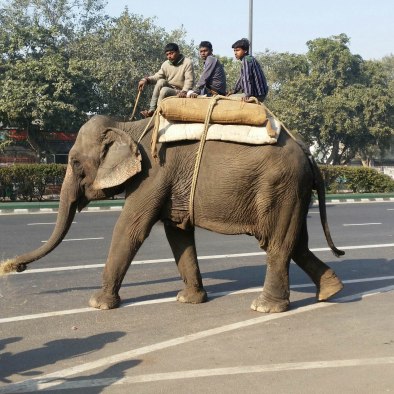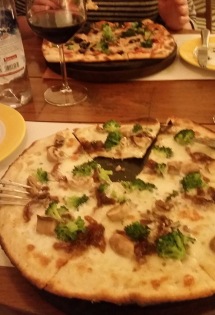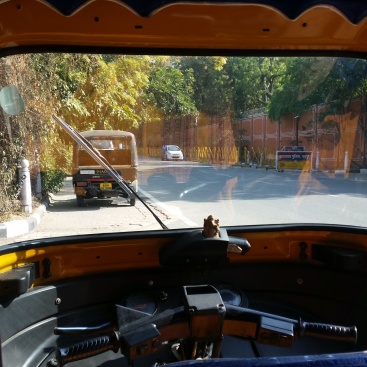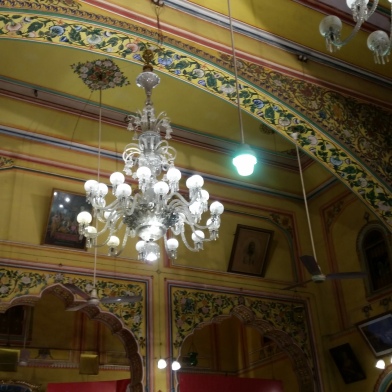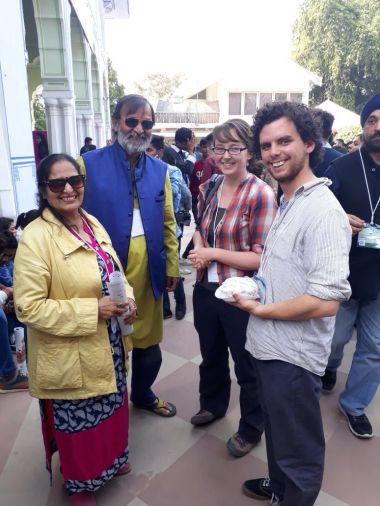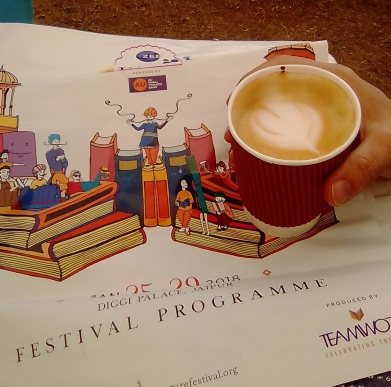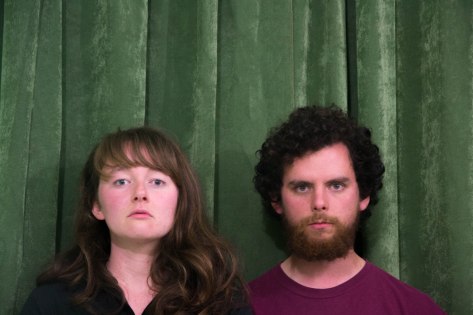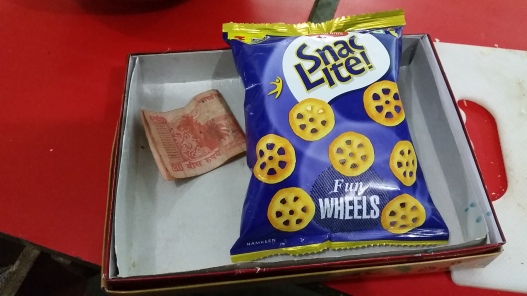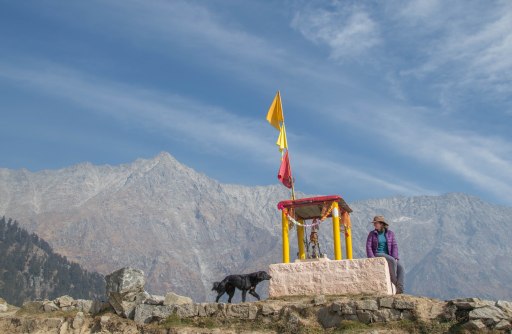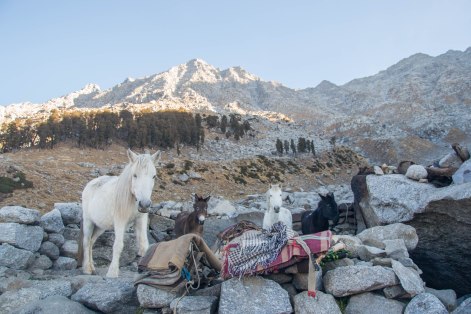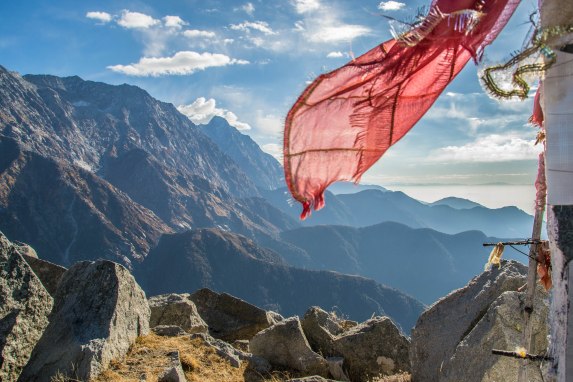8/2/18
Our first experience of travelling around Nepal began early one morning as we made the journey west out of Kathmandu towards Gaunshahar, a small mountain village in the centre of the country, where we would be working at a school for a couple of weeks. We left around 5am, leaving plenty of time for what we had heard might be a chaotic and challenging journey.
Travelling around Nepal is a vague and nebulous affair. There are many, many buses, but no such thing as a bus stop, nor a timetable. Whatever route you are taking, the general rule seems to be that most buses leave early in the morning, so best to turn up before breakfast time. If you are going somewhere major then there may well be buses going through the day, but they’ll probably taper off after lunch time, dependent perhaps on whether somebody with a bus reckons it’s worth their while to make a run that day. If you get there at the right time – ideally when one bus has just departed, and the next is yet to fill up – then you will be given a seat. Once all the seats are filled, the driver’s assistant will judge how many more people can be squeezed in, with buckets, planks, cushions and carpets laid out to seat a few extra, and a final couple of able-bodied souls will squeeze into the remaining standing room.
Once on the road, progress is inevitably slow – the roads are rough and rutted, and in many areas permanently congested for most of the day. After a few hours of bumping along, at some point there will be a rest stop, at a roadside restaurant/shop seemingly chosen based on the driver’s personal preference. On this particular journey, we were headed for Besisahar, a town in the centre of the country, between the main cities of Kathmandu and Pokhara. We heard that Besisahar had seen rapid expansion in recent years – previously a small village only notable for being the starting point of the Annapurna Circuit trek, it had become a sort of an Inverness, the only metropolis in a large and scenic rural area.
On the bus we pass through endless quarries and dust, and see glimpses of impossible mountains. We chat to a Nepali man who works in Dubai and Bahrain and only gets home once a year (‘It’s too short, I miss my family’). Clusters of corn are drying on racks, tiny goats lep about, women are washing, men brushing their teeth, spitting. Out over the ridge visions of mountains drift in the clouds. Terraced fields glow with golden mustard flowers, vibrant tatties, children on yellow buses. In the stifling heat which makes me mind drift and my heart miss a beat we swing uphill forever. Nepali pop music blares from the on-board TV, narrating stories of love lost and found and denied, pensioners doze, the door clatters open and closed.
Our journey to Besisahar was apparently unusually fast and smooth at only six hours long, and we arrived in plenty of time for the one daily bus up the mountain to Gaunshahar. After treating ourselves to lunch, we wandered over to the waiting bus and got on with a few minutes to spare. We then waited on the bus in intense heat for an hour as locals lackadaisically filtered on board, and the driver repeatedly got into his seat, thought about setting off, and then got off again. When we eventually did move, we stopped again around the first corner. The driver beeped his horn, and another man hurried out of a shop and onto the bus. He opened a compartment, removed a handful of remote controls and pressed several buttons, at which a TV mounted behind the driver’s seat sprang into life and began blasting saccharine Nepali pop songs at high volume, accompanied by their melodramatic colour-saturated videos. The sensory assault of the on-board entertainment system may have been intended as a distraction from the perilous journey up the mountain, as the rickety old coach wobbled and struggled up and around hairpin bends for another hour – but eventually we arrived at the village.
We help make dinner scrubbing gnarly tatties and chopping moolas, and meet the other volunteers. An ex-lawyer from Chile who swears a lot, a French girl who doesn’t know where she is going, a Danish man who has already been everywhere and another a German. They introduce us to evening ‘sharing and appreciation time’ (a bad sign, but we go along with it.) This is like a volunteer factory, we are all the same. Quit ma job man, want to see the world ken?)
Our fellow volunteers at Heaven Hill Academy were from all over – Brazil, France, Australia, Germany, Chile, Denmark, and we seemed to fit a recognisable pattern. Most had spent time in India before coming to Nepal, and were working at the school for a while before going on to spend some time trekking, just as we were. However, there were some ways in which we differed. We learned that most had chucked in their jobs in disgust or despair and decided to travel the world – one had been an accountant, one an auditor, one a lawyer, one an administrator – and were now embracing their new hippy lifestyle wholeheartedly after years of feeling constrained by the man. We couldn’t entirely join in with this ethos, sheepishly admitting that we’d both quite liked our jobs back home, and weren’t seeking spiritual enlightenment in Asia, just exploring new cultures and different parts of the world.
Neither were we able to muster much enthusiasm for the crowd-pleasing, toothless scraps of music, art, conversation and culture that drift together to make the shared campfire fodder of the travelling set. I left the UK with a vague impression of Ed Sheeran as an inoffensive redheaded singer who was popular among my old school pupils – now I have developed a full-blown allergy. It is doubtful whether Bob Marley will ever recover from the overexposure he has suffered, his omnipresence becoming a clichéd running joke. People volunteering at a rural school in Nepal don’t generally want to engage in a critical and analytical discussion of educational theories or funding models, they want to have fun with the cute kids, flirt with each other and feel good about themselves. And I don’t want to be cynical – they were all good people with good intentions having a good time and doing good things. But, just… Bob Marley around the campfire turned out to not really be our thing, any more.
9/2/18
The mountains are enormous and elusive, they’re like huge gods crouching, watching. At breakfast, the founder and headmaster of the school appears. He tells us we will be moving stones today, and then demands money for his new classroom. ‘We ask all the volunteers to donate something, you can choose’, and he shoves a list of items he needs under our noses. We are already paying 500Rs a day each to stay here, plus extra for lunch, on top of volunteering.
We arrive at school to choruses of hellos and namastes and rounds of high fives before standing for the national anthem, which one wee boy belts out harshly and passionately with eyes screwed shut. Some of the others are less enthusiastic. We introduce ourselves to the teachers, who eye us wearily and warily. I help the German guy with Grade 3, who are good craic and insist on stopping the lesson every few minutes to have races outside, sing a Nepali song or listen to their classmate recite his newest English love poem: ‘My love, we have known each other for three weeks, I walk to your village and in one week we will be married!’
Teaching the kids was one of the highlights of our time there. Since I was the only volunteer who worked as a teacher back home, I was mostly given the ‘Grade 3’ pupils to teach – the oldest and most advanced class in the school, aged between 9 and 12. In some ways it was just like teaching back in Scotland, and in some ways very different. The kids seemed delighted to come to school every day, which was one major difference, but their attitude to uniform was familiarly hit-and-miss. While the whiteboards, markers, pencils and books were fairly similar, the mud floor and bare stone walls were not. And while their English grammar understandably needed some help, they surprised me with a vocabulary which may well rival many kids of a similar age brought up in English-speaking countries. On the whole though, they substantiated my impression that kids are pretty much the same wherever you go: some shy, some bold; some honest, some sly; some more into books, some more into sports. Seemingly universally, sweeties take on a mystical quality engendering the strongest of emotions, and the possibility of doing something more ‘fun’ than what you’re supposed to be doing is worthy of more effort than it would take just to do it in the first place.
10/2/18
On our day off T and I head up the hill, zigzagging until we find a path we like. Suddenly the trees are speaking to us! ‘Namaste! Namaste!’ Wee lads are up the trees, hacking firewood! We come to a ridge and follow it north, pausing at hidden temples, adorned with garlands of dried flowers and straw, to peer inside. The floor is littered with offerings, wee oil lamps, flowers, red paste. The mountains tower behind rhododendron trees, the first red flowers just appearing.
11/2/18
The headmaster tells the story of the creation of Ganesha. ‘Shiva likes to smoke the marijuana, you know? A lot he smoke, and then he sleep, for many days, weeks maybe even. One time he smoke a lot a lot, and he fall asleep. Anyway, Shiva wife Parvati, she having a shower. And with all the dirt that come from the shower she make a statue, and she put in the doorway. And so this statue come alive, and is a guard. So then, Shiva he wake up and he go to his house. But this guard, not letting him in. So… Shiva very angry, and cut off the guard head! And he go into the house. Parvati see Shiva and she ask ‘How you get in? I put a guard in the door?’ And Shiva, he say, ‘I cut off his head!’ Parvati she very very sad, she cry, and she say ‘Why you cut off his head? He is my son.’ Then Shiva see some soldiers coming, and he say to them, ‘The first thing you find, that is alive, you cut off the head, and you bring to me.’ And the soldier go into the jungle and the first thing they find is elephant! So they cut the head, and bring to Shiva and Shiva put the head on the body of the guard and he come alive and he is a god, he is Ganesha!’
A wee boy in school pretends to be Shiva. ‘I am Shiva!’ He shouts, showing his muscles. ‘I am power!’
12/2/18
Reading The Three Little Pigs to some of the young kids. They are genuinely scared of the wolf, and cower when he knocks on the door. The French girl reads, ‘Well then I will ‘Hoooof and I will poooof and I will blow your house down!’
‘You are very fat!’ A wee boy says to me. ‘Well, you are very thin!’ I reply.
‘What is your name?’ ‘Cat.’ ‘Cat? I am rabbit!’ one shouts, and ‘I am mouse!’ ‘I am tiger!’
As we walk through the village a lady shouts from her shop ‘You are couple? You are married? When you will get married?!’
13/2/18
Shivaraatri. Shiva’s birthday. A huge bonfire roars outside the temple, chants come and go from within, the cow is adorned with flowers and red paint, huge quantities of marijuana, men singing and dancing on the path home.
14/2/18
The fire is still smouldering.
At night I think it’s raining, but it’s just an unusual wind in the trees. I go out and see more stars than I have ever seen before.
15/2/18
Walking in the quiet morning and it’s already hot. Mountains clear beyond the pink blossoms and oranges. A strange paradise, where every day is the same, every meal is the same, there are no young men, the old men are drunk, the women are working, and the children are (mostly) happy. The kids learn about the five senses, and climate, and spelling. Some of them skip to a hundred. Grade 1 do races, and I play rock, paper, scissors with the wee boy with a broken leg.
In the evening, the mountains turn pink and then fade in the dust. We play music under the holy tree and a drunk man staggers past, demanding that we dance.
Later, the headmaster says; ‘I know this a man, I know him. Many men like this in the village, very many. You must be a careful of him, a little bit…. The future is not bright for these children, I don’t know what will happen to them.’
The headmaster tells us that both private and state schools in Nepal still use corporal punishment liberally, and that this was one of his reasons for setting up Heaven Hill Academy. ‘You cannot hit the child’ he says, ‘inside him is a little man, and he remember, and he hit others.’
16/2/18
On days when school was closed, our job was to pitch in with building the new classroom, and there were a lot of these days because, since Nepal became a secular republic in 2008, the religious festivals of all major religions are observed as national holidays. The school started a few years ago with only very small children, and building work had essentially kept up with the oldest class, as they moved into a new classroom each year and new nursery-age kids arrived.
These days largely involved manual labour, but in a surprisingly fun way. There was a fairly large group of volunteers, and it gave great satisfaction to form a team or chain and see a huge pile of rocks move from one place to a more useful place, or a patch of ground cleared, flattened and prepared to become a new classroom. One day we had the fun job of collecting empty beer bottles from the whole village, and then fitting them together like a jigsaw puzzle to form an insulated floor for the new building, before concrete was poured in. We used the school’s PA system to play music while we worked, and there were plenty of breaks to chat about where we’d been and would like to go, and to learn words in each other’s languages.
The undoubted star of these days, though, was not one of the volunteers, but a local man named Dillu. Dillu was not an obvious labourer – tiny, scrawny, and seemingly constantly drunk. The headmaster employed him partly to help him out, as there didn’t seem to be any other work for him in the area. His payment was partially in food. But this man could carry more than anybody, even the massive French rugby player who had worked on construction sites for years and must have weighed twice as much as Dillu. He would carry 50kg bags of cement – probably heavier than he was – using just a piece of rope pulled over his forehead, and he’d do it all day long. It took two of us just to help get the sacks onto his back, but he would ferry them for hours with a smile. He was delighted when it was volunteers’ pizza night and we made some for him, and one night when we were asked to share what we were thankful for that day, the French builder was almost overcome with emotion talking about the marvels he had witnessed working with Dillu – ‘zis fucking guy! He is incroyable!’
17/2/18
Almost back in town after a walk we see a band of white-faced monkeys, just outside the village. Suddenly, the village lads come hurtling down the path screaming and shouting. The monkeys leap from the trees and flee in terror. A wee one takes a huge jump from a tree just behind us, about 40 feet high, and lands with a crash on his side. He doesn’t move. ‘Fuck, I think he’s dead!’ The lads are still running towards him, screaming, and miraculously he picks himself up and lopes off into the forest.
The Chilean tells us about Iran around a camp fire. How it’s a dry country, so the youngsters party with no alcohol, and recite poems in the dark. ‘Are there women?’ ‘Of course there are women. I stayed with some. A few. I actually had sex with one’ he whispers. ‘And the bread in Iran, is huge, huge, so good, beautiful, just beautiful.’
19/2/17
Final Dahl Bhat. Unemotional farewells. We are perched on the edge of the spare tyre in the back of the jeep, hanging onto the metal frame. As we bump over the bridge into Besisahar my bum goes completely numb and man glancing up from the road sees us flying about and bursts into laugher!
The driver pulls up beside a wee micro-bus which is about to depart. He screams out the window in Nepali ‘…. Kathmandhu?’ T jumps out and it’s the end. We have been together every day, for three months, but now I won’t see him for a week as he is traveling back to Scotland for a family funeral.
I wait on the side of the road. Strangely alone. A bus casually pulls up about every five minutes, but none of them say Pokhara. Then I see a bag on top of a micro-bus which looks just like T’s bag, and then T himself is knocking frantically at one of the windows and he manages to pull it open and is just beginning to tell me something when it pulls away. ‘Goodbye’ ‘Goodbye!’ The bus disappears into the dust and I feel a lump in my throat.


























































